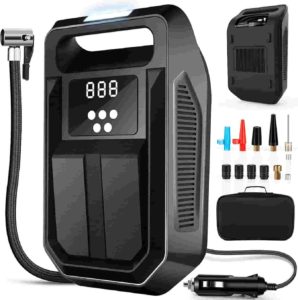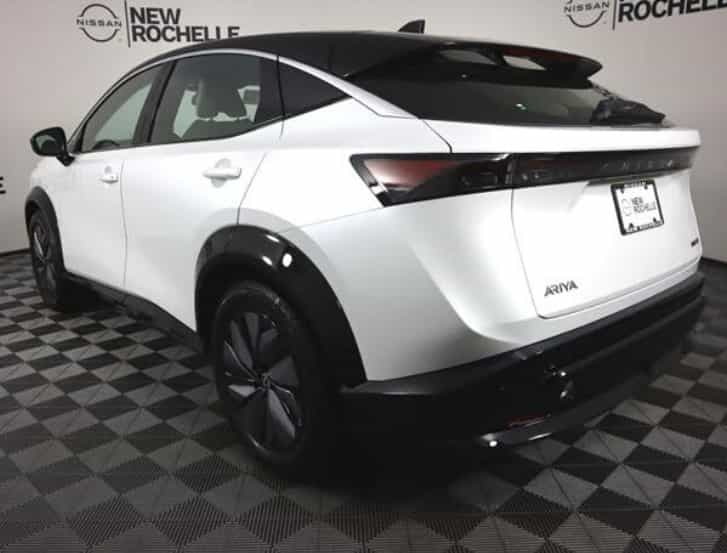2023 Nissan Ariya Tire Pressure Monitoring System
The Tire Pressure Monitoring System (TPMS) is an automated system in your Ariya that monitors the air pressure inside your tires. Navigating the ins and outs of your Nissan Ariya’s TPMS can seem daunting, but it doesn’t have to be. Maintaining the correct tire pressure in electric vehicles (EVs) like the Nissan Ariya is crucial as it directly impacts the vehicle’s range. This comprehensive guide will walk you through everything you need to know about your Ariya’s TPMS, from resetting the tire pressure light to understanding how weather affects tire pressure. Whether you’re a new Ariya owner or a seasoned driver, this guide will help you maintain optimal tire pressure, ensuring a smooth, efficient, and safe ride every time. So, buckle up and let’s dive into the world of tire pressure management for your Nissan Ariya!
Steps to Reset the Nissan Ariya Tire Pressure Light
The Nissan Ariya does not have a tire pressure reset button. It has what is called “Easy-Fill Tire Alert” which provides you with audible and visual signals while inflating your tires.
Park your Ariya in a safe and level place.
Apply the parking brake and put the SUV in Park.
Put the ignition to the ON position. This means engine off, electricity on.
Check and adjust your tire pressures. As you start adding air, the hazard indicators will start flashing.
Once the correct amount of air has been reached, the horn of your Ariya will beep once and the hazard indicators will stop flashing. Be exact, if you have 19” wheels, make sure to fill the front and rear tires to exactly 46 Psi.
Repeat the same steps for every tire. (if the tire is overinflated by more than 4 Psi, the horn will beep and the hazard indicators will flash 3 times, release some air.)
After adjusting the tire pressure, drive the vehicle at speeds above 16 MPH (25 km/h). The low tire pressure warning light does not automatically turn off when the tire pressure is adjusted. Once the Ariya reaches 16 MPH (25 km/h) or more, the light will turn off.
If the low tire pressure warning light flashes for approximately 1 minute and then remains on after you turn the ignition switch to the ON position, the TPMS is not functioning properly. (read more about TPMS malfunction below)
If the light doesn’t go off right away, re-check your tire pressure to make sure they are all at the exact pressure you set them to. If the pressure has decreased, you probably have some sort of leak in that tire.
If your tires are not losing air and the tire light still won’t go out, overfilling your tires by about 10 Psi might wake up your sensors. So, overfill them and then drive the Ariya for a few minutes. The tire light should reset. Remember: DO NOT leave the tires at this level, release the extra 10 Psi afterwards.
NOTE: Your TPMS will not reset and turn off the low tire pressure warning light until the tire pressure is set to the recommended pressure and the vehicle is driven at speeds above 16 MPH (25 km/h). If you’ve completed these steps and the tire light STILL won’t go out, There is only one of three things that can be the problem. Either have a faulty tire pressure sensor in one of your wheels OR you have a leak OR your receiver module (control unit) is not communicating with your sensors (this is the least of all likely and is rare).
2023 Nissan Ariya Tire Pressures
TIRE SIZE | FRONT PSI | REAR PSI |
255/45R20 | 41 | 41 |
235/55R19 | 46 | 46 |
SPARE TIRE | 60 | 60 |
Tire Settings
How to Reset the Tire Maintenance Reminder Light
Press the “Menu” button on the steering wheel.
Use the arrow buttons to select “Settings“.
Scroll down and select “Vehicle Settings“.
Then select “Maintenance” and then “Tire“.
Select “Reset” and then “Yes“.
How to Change Tire Pressure Units
Press the “Menu” button on the control panel.
Select “Settings“.
Scroll down and select “Vehicle Settings“.
Scroll down and select “Tire Pressures“.
Select “Pressure Unit“.
Choose between “psi”, “kPa”, or “bar” as your preferred unit of measurement.
How Does the Nissan Ariya TPMS Work?
The Tire Pressure Monitoring System (TPMS) in the Nissan Ariya is a sophisticated system designed to monitor the air pressure inside the tires. The system is designed to alert the driver when tire pressure is too low. Here’s a detailed explanation of how it works:
Tire Pressure Sensors: Each tire (including the spare, in some models) is equipped with a pressure sensor mounted directly onto the wheel at the end of the tire’s air valve. These sensors are battery-powered and are designed to last for several years. The sensor measures the air pressure inside the tire and also detects the temperature.
Data Transmission: The tire pressure sensors transmit this data wirelessly. Each sensor has a unique identification number, which is transmitted along with the pressure and temperature data. This allows the system to know which tire each set of data is coming from. The sensors transmit data to the TPMS receiver module at regular intervals, or when a significant change in pressure or temperature is detected. The sensors also transmit data when the vehicle is started and starts moving.
TPMS Receiver Module: The TPMS receiver module, also known as the TPMS control unit, is the component that receives the wireless signals from the tire pressure sensors. It decodes the signals, using the unique identification number to determine which tire each set of data is coming from. The receiver module then sends this data to the vehicle’s electronic control unit (ECU).
Electronic Control Unit (ECU): The ECU is the vehicle’s onboard computer system. It processes the data received from the TPMS receiver module. If the ECU determines that the pressure in one or more tires is significantly below the recommended level, it will trigger a warning light on the vehicle’s dashboard. This is the “low tire pressure” warning light, which is an icon that looks like an exclamation point inside a tire. The Ariya, also displays the actual tire pressures and temperatures on the vehicle’s information display.
TPMS with Easy Fill Tire Alert: As we mentioned above, the Nissan Ariya also features an “Easy Fill Tire Alert system” which is part of the tire pressure system. This system provides visual and audible signals to help you inflate your tires to the correct pressure.
The TPMS is a valuable safety feature that can help you maintain your tires at the correct pressure, which can improve your vehicle’s handling, decrease tire wear, reduce braking distance, improve EV range, and prevent tire blowouts. However, it’s still important to manually check your tire pressures regularly, as the TPMS is not a substitute for proper tire maintenance.
What is a TPMS Malfunction?
The Nissan Ariya’s tire pressure monitoring system also has a malfunction indicator to alert you when something is wrong with the system itself. The indicator uses the same yellow exclamation point as the low tire pressure light. The difference is that, if there is a problem with the system, the light will flash for approximately 60 seconds before staying on. This flashing or blinking will happen every time you start your Ariya until the issue is resolved. When your tire light is flashing your Ariya will not be able to give you accurate pressure readings. Basically, a blinking tire pressure light means there is a malfunction within the TPMS itself, rather than an air pressure issue. This is usually due to a faulty pressure sensor in one of your tires (a dead battery) or driving with the spare tire. (if the spare doesn’t have a sensor in it) To figure out which sensor is malfunctioning or faulty, use a TPMS diagnostic tool and scan each sensor for diagnostic information or bring your car to a professional.
What Causes a TPMS Malfunction?
Using non Nissan wheels or tires.
Interference from devices that utilize the same radio frequencies (typically 315 MHZ or 433 MHz) can lead to complications with the Tire Pressure Monitoring System (TPMS), resulting in performance problems. This interference can stem from a wide range of sources, including everyday items like a radio or a nearby store’s security system.
If your Ariya has heavily tinted windows, it could potentially disrupt the radio signals being exchanged between the TPMS sensors and the receiver.
If there’s significant snow or ice build-up on or around the tire valves
If the tire pressure is extremely high.
If wheels without tire pressure sensors are installed on the car. This includes the spare tire if your spare does not have a sensor in it.
If new tire pressure sensors are installed without registering the new sensor IDs with the Ariya’s receiver module/ECU.
What Causes the Tire Light to Turn On?
Seasonal temperature changes: A drop in ambient temperature can cause tire pressure to decrease, triggering the warning light.
Tire puncture or leak: A sharp object or road debris like a nail or screw may puncture a tire, causing air loss which will of course activate the warning light.
Faulty tire pressure sensor: Damaged or malfunctioning sensors may provide inaccurate readings, resulting in a false alert. The only way to determine which sensor is faulty is to scan each sensor with a TPMS diagnostic tool.
Valve stem issues: A damaged or leaking valve stem can lead to gradual pressure loss and eventual activation of the tire pressure light. They make kits to replace the rubber gasket that usually goes bad.
Tire damage: Impact from potholes or hitting a curb can cause structural damage like tire bubbles, leading to pressure loss.
Sensor battery life: TPMS sensors are battery-powered, and over time, batteries die. (they usually last anywhere from 5-10 years) This will cause the tire pressure light to turn on. Again, you must use a diagnostic tool to determine which sensor is dead or dying.
Recent tire rotation or replacement: If the tires have been recently rotated or replaced, the TPMS may need recalibration to avoid false alerts. Sometimes the vehicle’s computer may think the front tires are in the rear and rear in the front after a rotation.
Wheel or rim issues: Damaged, corroded, or cracked wheels or rims can lead to air leaks and pressure loss. This is very common with low profile tires.
Altitude changes: Climbing or descending in elevation can affect tire pressure and trigger the TPMS warning. An additional 1.5 Psi per Km above sea level is required.
Natural pressure loss: Tires lose air pressure over time due to temperature changes and permeation. Tire dry-rot will happen to tires that sit.
Electrical problems or software issues within the car’s TPMS system. Occasionally the system may have a software update from Nissan.
Snow Tires: If you have a separate pair of wheels/rims for your snow tires, you can either transfer the sensors from your summer wheels or acquire an additional set of 4 sensors for the second pair of wheels/rims. However, if you are using the same wheels for both sets of tires, there is no need to be concerned about this.
What Happens When Tires are Underinflated or Overinflated?
When tires are underinflated or overinflated in your Nissan Ariya, several issues can arise:
Underinflated Tires:
Reduced Range: Underinflated tires increase rolling resistance, which means the vehicle’s electric motor has to work harder to maintain speed. This can reduce the vehicle’s range on a single charge.
Decreased Handling: Underinflated tires can negatively impact the vehicle’s handling and responsiveness, making it harder to steer and potentially increasing the risk of an accident.
Increased Tire Wear: Tires that are underinflated tend to wear out quicker, especially on the outer edges. This can lead to premature tire replacements.
Overheating Risk: Underinflated tires can generate excess heat, which can lead to tire failure, especially at high speeds or during long drives.
Overinflated Tires:
Harsher Ride: Overinflated tires will result in a harsher, less comfortable ride as they are less able to absorb the impact from bumps and potholes.
Increased Wear in the Center: Overinflated tires tend to wear more in the center, which can also lead to premature tire replacement.
Decreased Traction: Overinflated tires have a smaller contact patch with the road, which decreases traction and makes the Ariya more susceptible to skidding or hydroplaning in wet conditions.
Increased Risk of Damage: Overinflated tires are more susceptible to damage from potholes and other road hazards.
In both cases, maintaining the correct tire pressure is not a suggestion. It’s necessary for the Nissan Ariya to perform at its best!
Does the Weather Affect Tire Pressure?
In the Nissan Ariya, as with any vehicle, weather conditions can significantly impact tire pressure. During colder months air contracts, which leads to a decrease in tire pressure. Conversely, in warmer weather, air expands which causes an increase in tire pressure. These fluctuations can affect the Ariya’s performance, efficiency, and safety. Therefore, it’s crucial to regularly check and adjust the tire pressure in your Ariya, especially when there are significant changes in weather. A general rule of thumb states that for every 10-degree Fahrenheit change in temperature, tire pressure will decrease or increase by approximately 1 psi in the same direction.
How to Adjust Tire Pressure?
Make sure the tires are cold.
Remove the valve caps from the tires.
Press the tip of the tire pressure gauge onto the valve and read the pressure.
If the tire pressure is below the recommended level, fill the tire until the recommended pressure is reached. If the tire pressure is above the recommended level, release air until it reaches the recommended pressure. (Press the metal stem in the center of the tire valve. You can use any object like a screwdriver to do this. Be gentle.)
After adjusting the tire pressure, don’t forget to put the valve caps back on to prevent leaks and keep dirt and moisture out.
Repeat this process for each tire, including the spare if applicable.
When Should You Adjust Tire Pressure?
For an accurate tire pressure reading on your Nissan Ariya, check it when the car hasn’t been driven for a bit, ideally in the morning. This is called checking the “cold pressure” after the car has been parked for around three hours or more. Driving heats up your tires, making the air inside increase and giving falsely high pressure readings. So, don’t adjust your tire pressure just after driving, or your tires will be overinflated!
Conclusion
In conclusion, understanding and maintaining the Tire Pressure Monitoring System (TPMS) in your Nissan Ariya is not just about keeping a light off on your dashboard. It’s about ensuring optimal performance, safety, and longevity of your vehicle. From understanding how to reset the tire pressure light to knowing the effects of underinflation and overinflation, this guide has equipped you with the knowledge to keep your Ariya running smoothly. Remember, regular tire pressure checks and adjustments are key, especially with the influence of weather changes. So, keep this guide handy, and enjoy the peace of mind that comes with knowing you’re taking the best care of your Nissan Ariya. Happy driving! Everything in this article is applicable to all Nissan Ariya models and trims. Including Ariya FWD & AWD, Ariya Engage, Ariya Venture+, Ariya Evolove+, Ariya Platinum+ E-4orce.
Please note that this blog post contains Amazon affiliate links. This means that if you make a purchase through one of these links, we at TPMSRESET.com may earn a small commission at no extra cost to you. We only recommend products that we personally use and believe in. Thank you for supporting us.





